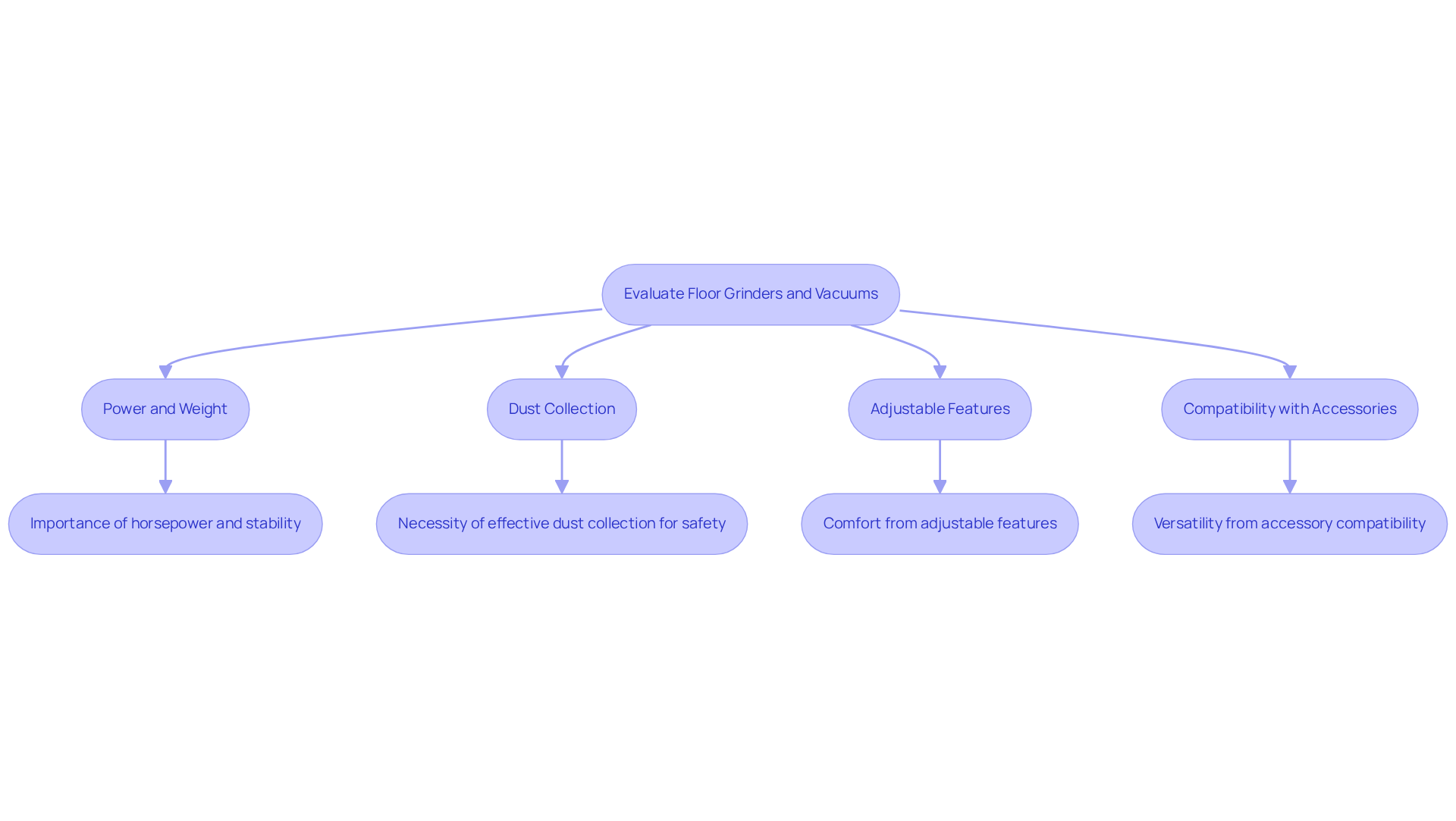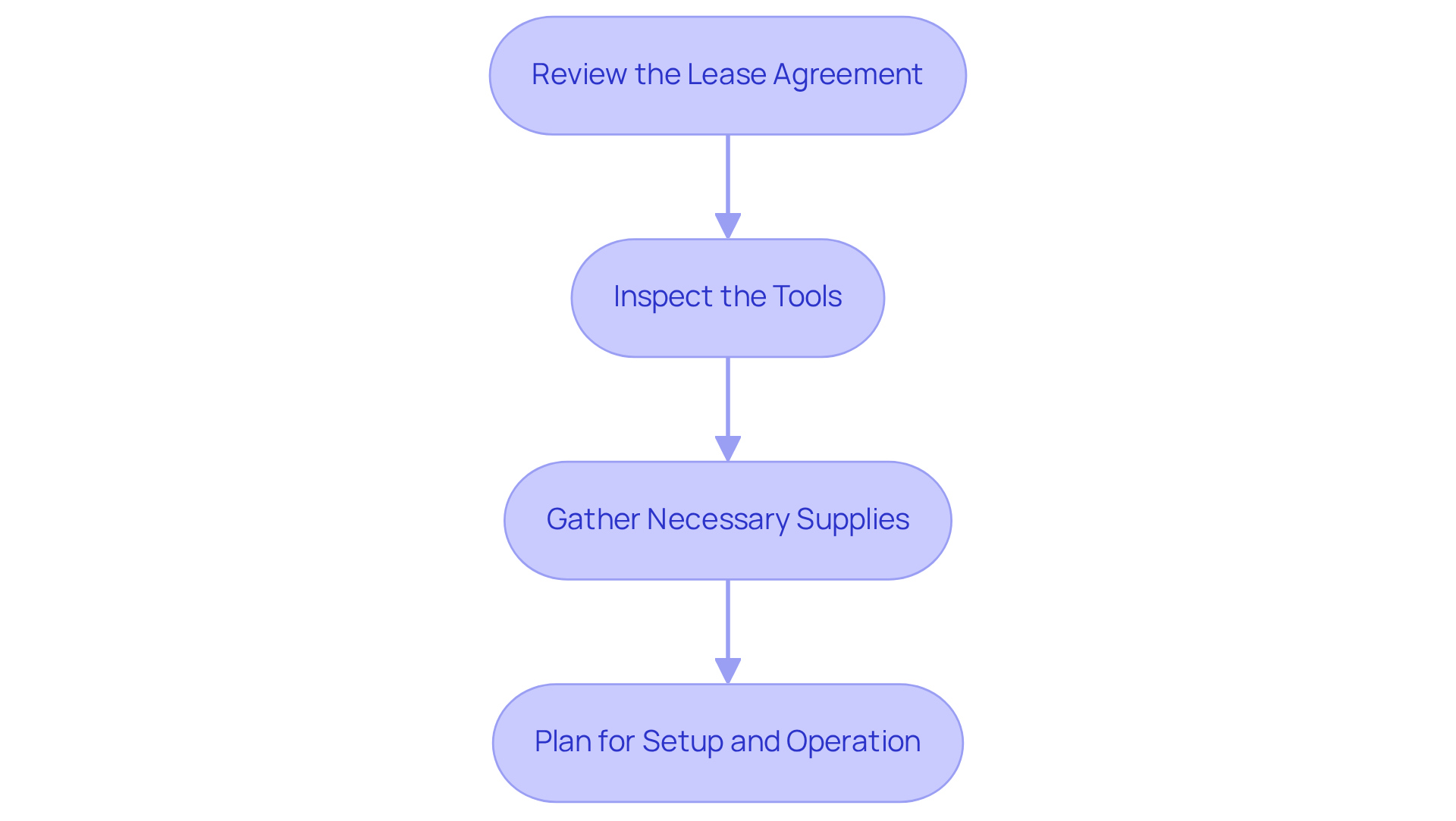Overview
This article presents four essential steps for effectively renting a floor grinder with a vacuum. These steps include:
- Assessing project requirements
- Evaluating equipment features
- Managing rental costs
- Finalizing the rental agreement
Each step underscores the significance of meticulous planning and preparation, such as understanding the types and sizes of surfaces involved, comparing rental costs, and inspecting tools to guarantee efficiency and safety during operation.
To begin, assessing project requirements is crucial. Understanding the specific needs of your project will help you select the right equipment. For instance, consider the surface type and size to ensure optimal performance. Furthermore, evaluating equipment features allows you to determine which tools best meet your needs, ensuring reliability and quality.
Managing rental costs is another vital step. By comparing prices across different rental services, you can secure the best deal without compromising on quality. Additionally, finalizing the rental agreement should be approached with care, ensuring that all terms are clear and favorable. This careful attention to detail will not only enhance efficiency but also contribute to a safer operational environment.
In conclusion, following these steps will streamline the rental process, ensuring that you receive the best equipment for your project. Take action now by assessing your needs and exploring your rental options to achieve success in your upcoming projects.
Key Highlights:
- Assess the surface type (concrete, tile, etc.) to determine suitable sharpening techniques and equipment.
- Measure the area size to choose the appropriate grinder type; larger areas may require walk-behind models.
- Define the desired finish, such as smoothness or coating removal, which affects pad and tool selection.
- Consider additional tasks like polishing or sealing, which may require rental of extra equipment.
- Prioritise grinders with adequate power (e.g., 1.5 horsepower) and weight for stability and performance.
- Choose grinders with effective dust collection systems to ensure safety and clean work environments.
- Look for adjustable features and compatibility with various accessories for versatility in tasks.
- Compare leasing costs from different providers and be aware of additional fees that may impact the budget.
- Understand rental duration options (hourly, daily, weekly) to select the most cost-effective choice.
- Review insurance and liability terms in lease agreements to understand responsibilities and financial exposure.
- Engage with rental companies about maintenance policies to prevent delays and additional expenses.
- Inspect rental tools before acceptance to document any pre-existing damage and avoid liability.
- Gather necessary supplies (pads, safety gear) to enhance efficiency and ensure safety during operation.
- Familiarise yourself with the equipment manual and arrange training if needed to reduce operational risks.
Introduction
Navigating the world of floor grinding can be a daunting task, particularly when it involves selecting the right equipment and ensuring a successful rental experience. However, with a strategic approach, this endeavor can efficiently and effectively transform surfaces. This guide outlines the essential steps for renting a floor grinder with a vacuum, from assessing project requirements to finalizing agreements. What are the critical factors that can determine the success of your rental experience? Let's explore.
Identify Project Requirements for Floor Grinding
- Assess the Surface: Begin by evaluating the type of surface you will be polishing. Is it concrete, tile, or another material? Each surface requires specific sharpening techniques and equipment that are tailored to its properties.
- Determine the Area Size: Measure the total area that needs grinding. This measurement is crucial in determining the size and type of mill required. For larger areas, more powerful, walk-behind grinders can offer efficiency, while smaller spaces might only necessitate handheld models.
- Define the Desired Finish: Consider the finish you aim to achieve. Are you looking for a smooth surface, or is it necessary to remove coatings like paint or epoxy? This decision will significantly influence your selection of polishing pads and tools.
- Identify Additional Needs: Reflect on any extra tasks that may need to be addressed, such as polishing or sealing after the surface preparation. This may involve renting a floor grinder with vacuum rental or other tools to ensure a comprehensive finish.

Evaluate Features of Floor Grinders and Vacuums
- Power and Weight: When selecting a floor machine, it is essential to prioritize models that possess adequate power, typically measured in horsepower, to effectively tackle your specific grinding tasks. For instance, many milling machines are rated at 1.5 horsepower. Heavier machines generally provide enhanced stability and performance, which is particularly advantageous for larger areas, as they can grind more efficiently with minimal vibration. Furthermore, certain machines can accommodate up to 80 lbs. of additional weight via their built-in weight tray, thereby improving grinding performance. Notably, the floor grinder with vacuum rental is part of the walk-behind floor machines that are projected to capture a 40.2% market share in 2023, underscoring their popularity and reliability in the rental market. As Jim Cuviello from Cuviello Concrete and Terrazzo Polishing aptly states, "Remember the heavier the machine and the larger the motor, the more power you'll need."
- Dust Collection: Opt for a floor grinder with vacuum rental that comes equipped with integrated vacuum systems or is compatible with high-efficiency particulate air (HEPA) vacuums. Effective dust collection is crucial not only for maintaining a clean work environment but also for ensuring the safety of both operators and bystanders. Research shows that advanced dust collection systems can significantly diminish airborne particles, thereby enhancing overall air quality at job sites.
- Adjustable Features: Seek out devices that feature adjustable handles and variable speed settings. These enhancements contribute to user comfort and provide better control over the milling process, allowing operators to adapt more effectively to various surfaces and conditions.
- Compatibility with Accessories: It is vital to ensure that the grinder can accommodate a wide range of polishing pads and accessories. This versatility allows for adaptation to diverse tasks, whether it involves light grinding, surface preparation, or cleaning, thereby increasing the tool's value across different projects.

Assess Rental Costs and Terms for Budget Management
- Compare Leasing Costs: Conduct thorough research to compare leasing costs from various providers, including EZ Equipment Rental in Dallas, which offers competitive pricing that often undercuts rivals. Be mindful of additional costs, such as delivery fees or security deposits, which can impact your overall budget. Understanding these factors is essential for making informed financial decisions.
- Understand Rental Duration: Assess the duration for which you will need the equipment. Lease firms generally provide tiered pricing depending on the duration of the lease, including hourly, daily, and weekly choices. By grasping these tiers, you can select the most cost-effective option for your project, ensuring optimal resource allocation.
- Check for Insurance and Liability: Carefully review the lease agreement to understand the insurance coverage and liability terms. It's crucial to know your responsibilities in the event of damage or accidents, as this can significantly affect your budget. A comprehensive understanding of these terms will safeguard your interests and financial planning.
- Inquire About Maintenance and Support: Engage with the rental company regarding their maintenance policies. Understanding whom to reach out to for assistance or issues with tools can avert delays and extra expenses during your project. Efficient handling of maintenance can also prolong the lifespan of the machinery, contributing to overall project effectiveness. As Josh Nickell, Vice President of [the American Rental Association’s equipment segment](https://ezequipmentrental.com), states, "You can’t just assume that there’s a piece of equipment on your lot or hope one will be back in time; you have got to do a lot more planning, and use analytics to forecast what your needs are going to be." This insight underscores the importance of proactive planning in equipment rental.
Finalize Rental Agreement and Prepare for Use
- Review the Lease Agreement: Before signing, it is imperative to thoroughly examine the lease agreement. Ensure clarity on all terms, including rental duration, costs, and responsibilities, to avoid any potential misunderstandings.
- Inspect the Tools: Prior to acceptance, conduct a meticulous examination of the tools. Look for any pre-existing damage and document these issues thoroughly. This step is crucial; neglecting to check can lead to disputes and legal responsibilities, as tenants may be held accountable for any safety concerns arising from the tools. Industry data indicates that failing to perform inspections can result in significant downtime expenses, averaging $1,400 per day during critical periods due to machinery failures. Furthermore, the case study titled "Importance of Inspecting Rental Equipment" underscores the necessity of inspections to mitigate safety hazards and legal liabilities.
- Gather Necessary Supplies: Assemble any additional supplies required for the job, such as grinding pads, safety gear (gloves, goggles, masks), and cleaning materials. Being well-prepared not only enhances efficiency but also ensures safety during operation.
- Plan for Setup and Operation: Familiarize yourself with the device's operation manual. If possible, arrange a brief training session with the rental company regarding the floor grinder with vacuum rental to ensure you can operate the equipment effectively. Regular inspections and proper training can significantly reduce the risk of accidents, as many injuries in the construction industry stem from equipment failures. By prioritizing these steps, you can enhance both safety and productivity on your project.

Conclusion
Successfully renting a floor grinder with a vacuum necessitates meticulous planning and execution. By adhering to the outlined steps, one can ensure the selection of the right equipment, fulfillment of project requirements, and effective cost management. Understanding the nuances of each stage—from assessing surface types to finalizing rental agreements—can profoundly influence the overall success of the floor grinding project.
Key insights underscore the significance of:
- Assessing project requirements
- Evaluating equipment features
- Managing rental costs
- Preparing for effective use
Each of these steps is vital in guaranteeing that the chosen floor grinder aligns with the specific needs of the project while adhering to budgetary constraints. Furthermore, engaging with rental companies and comprehending their policies can enhance the rental experience and mitigate potential issues.
Ultimately, thorough preparation and informed decision-making are essential for achieving optimal results in floor grinding projects. By investing time to understand the equipment, costs, and operational procedures, individuals can improve both the efficiency and safety of their projects. Embracing these strategies not only leads to immediate success but also cultivates a more knowledgeable approach to future rental endeavors.
Frequently Asked Questions
What is the first step in identifying project requirements for floor grinding?
The first step is to assess the surface type you will be polishing, such as concrete, tile, or another material, as each requires specific techniques and equipment.
How do I determine the size of the area that needs grinding?
You should measure the total area that needs grinding, as this measurement is crucial for selecting the appropriate size and type of mill needed for the project.
Why is it important to define the desired finish before starting floor grinding?
Defining the desired finish is important because it influences the selection of polishing pads and tools, determining whether you need a smooth surface or if you need to remove coatings like paint or epoxy.
What additional needs should I consider when preparing for floor grinding?
You should consider any extra tasks that may need to be addressed, such as polishing or sealing after surface preparation, which may require renting a floor grinder with vacuum rental or other tools for a comprehensive finish.




